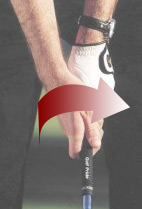How to Cure a Hook - Start With Your Wrists Ah the golf hook...only slightly less annoying than a slice. I've heard many golfers say "a hook is much more difficult to fix than a slice". I think the reason is that a slice is much more common to develop first than a hook. Then, in trying to fix a slice, golfers over-compensate and then develop a hook and in doing so, start to develop some pretty ingrained habbits. Ah the golf hook...only slightly less annoying than a slice. I've heard many golfers say "a hook is much more difficult to fix than a slice". I think the reason is that a slice is much more common to develop first than a hook. Then, in trying to fix a slice, golfers over-compensate and then develop a hook and in doing so, start to develop some pretty ingrained habbits.
If the main reason for a slice is that your club face is open at impact with the ball, then it would make sense to say that the main reason for a hook is that the club face is closed when making contact with the ball. Coupled with a "baseball swing" follow through as opposed to ensuring the club head follows through to your intended target and you've got yourself a pretty nasty duck hook. If you are hitting low line drive hook shots, then there may be multiple things going on with your swing. Most likely your club face is closed at impact, you're swinging around your body on your follow through instead of more up/down and straight at your target, and you may be swinging with an "in-out" swing meaning that on your downswing your hands are moving your club away from your body. If you can imagine your club moving further away from your body as you swing, along with making contact with the ball with a closed club face, you should be able to imagine a pretty severe rotation of the ball which will result in a hook. But, let's assume you are getting the ball in the air, and that you do not have such a severe "line drive" hook. You're getting the ball in the air, but no matter what you do, the ball continues to hook. The first thing to consider is your wrist action as you make contact with the ball. It is absolutely imperative that your wrists are locked into position as you strike the ball and start your follow through. As soon as your wrists start to turn over, you are closing your club face and increasing the chances of a hook. I find that by rotating my bottom hand over and closing the space between my thumbs works wonders to lock in my grip. So instead of my thumbs being more side-by-side when I grip the club, the thumb on my bottom hand is basically laying on top of the thumb on my top hand. It may feel awkward but this has really worked wonders for me. The second thing to concentrate on is ensuring that your club face follows through towards your intended target. To help this you should make sure your palm of your bottom hand is facing in the direction of your target at impact with the ball. What you do not want to do is swing around your body after you make contact with the ball, resulting in more of a baseball type swing. Instead you should try and emulate a more vertical swing. A golf hook is tough to eliminate, there is no doubt about it. But, by changing a few subtleties in your swing, you can quickly turn a hook into a controllable draw and start landing some pretty nice shots. Technorati Tags: golf hook golf tips golf swing improvement duck hook |

|
|
